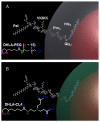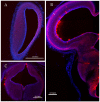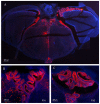Delivery and tracking of quantum dot peptide bioconjugates in an intact developing avian brain
- PMID: 25688887
- PMCID: PMC5056627
- DOI: 10.1021/acschemneuro.5b00022
Delivery and tracking of quantum dot peptide bioconjugates in an intact developing avian brain
Abstract
Luminescent semiconductor ∼9.5 nm nanoparticles (quantum dots: QDs) have intrinsic physiochemical and optical properties which enable us to begin to understand the mechanisms of nanoparticle mediated chemical/drug delivery. Here, we demonstrate the ability of CdSe/ZnS core/shell QDs surface functionalized with a zwitterionic compact ligand to deliver a cell-penetrating lipopeptide to the developing chick embryo brain without any apparent toxicity. Functionalized QDs were conjugated to the palmitoylated peptide WGDap(Palmitoyl)VKIKKP9GGH6, previously shown to uniquely facilitate endosomal escape, and microinjected into the embryonic chick spinal cord canal at embryo day 4 (E4). We were subsequently able to follow the labeling of spinal cord extension into the ventricles, migratory neuroblasts, maturing brain cells, and complex structures such as the choroid plexus. QD intensity extended throughout the brain, and peaked between E8 and E11 when fluorescence was concentrated in the choroid plexus before declining to hatching (E21/P0). We observed no abnormalities in embryonic patterning or embryo survival, and mRNA in situ hybridization confirmed that, at key developmental stages, the expression pattern of genes associated with different brain cell types (brain lipid binding protein, Sox-2, proteolipid protein and Class III-β-Tubulin) all showed a normal labeling pattern and intensity. Our findings suggest that we can use chemically modified QDs to identify and track neural stem cells as they migrate, that the choroid plexus clears these injected QDs/nanoparticles from the brain after E15, and that they can deliver drugs and peptides to the developing brain.
Keywords: Nanoparticles; choroid plexus; normal embryonic chick brain development; peptidyl delivery; quantum dots; zwitterion.
Figures







References
-
- Son S, Hwang DW, Singha K, Jeong JH, Park TG, Lee DS, Kim WJ. RVG peptide tethered bioreducible polyethylenimine for gene delivery to brain. J. Controlled Release. 2011;155:18–25. - PubMed
-
- Alvarez-Erviti L, Seow Y, Yin H, Betts C, Lakhal S, Wood MJ. Delivery of siRNA to the mouse brain by systemic injection of targeted exosomes. Nat. Biotechnol. 2011;29:341–345. - PubMed
-
- Sharma G, Modgil A, Zhong T, Sun C, Singh J. Influence of short-chain cell-penetrating peptides on transport of Doxorubicin encapsulating receptor-targeted liposomes across brain endothelial barrier. Pharm. Res. 2014;31:1194–1209. - PubMed
-
- Cooper I, Sasson K, Teichberg VI, Schnaider-Beeri M, Fridkin M, Shechter Y. Peptide derived from HIV-1 TAT protein destabilizes a monolayer of endothelial cells in an in vitro model of the blood-brain barrier and allows permeation of high molecular weight proteins. J. Biol. Chem. 2012;287:44676–44683. - PMC - PubMed
Publication types
MeSH terms
Substances
Grants and funding
LinkOut - more resources
Full Text Sources
Other Literature Sources
Miscellaneous

